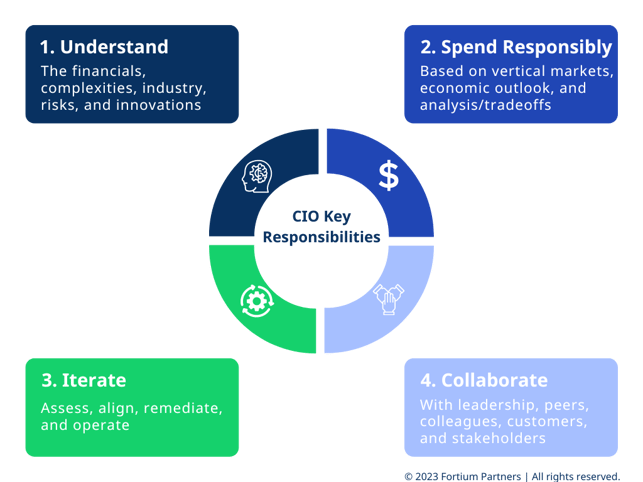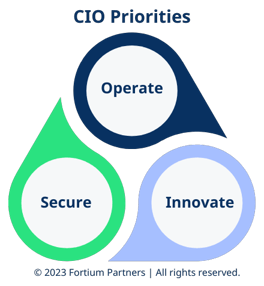4 Situations that Determine When a CIO is Needed
As the number of employees grows, the complexity of the technology and the opportunity to use technology for innovation grows, and the cost/benefit of using a Managed Service Provider (MSP) begins to decline. Most organizations will transition from a purely outsourced relationship with an MSP to a co-managed technology model as early as 50-150 employees and progress to a mostly internal technology model by the time they reach 150-250+ employees. As the organization adds employees, contractors, and financial resources dedicated to managing technology, the need for a CIO to oversee the growing technology organization increases proportionately. These organizations will move to higher utilization of a fractional CIO from 1-2 days per week to 2-3 days per week or to their first full-time CIO.
There are four situations, however, where the need for a CIO is based on other factors driving the importance of technology in an organization rather than the number of employees:
-
A rapidly growing, technology-enabled business with complex technology requirements or dependencies where a significant security incident or technology outage would have an outsized impact on the organization's revenue or reputation (e.g., eCommerce, fintech, banking, etc.),
-
An organization with significant data security and compliance concerns, such as those in healthcare or financial services or whose customers are required to hold their vendors to these higher standards,
-
An organization whose customers rely on its technology to facilitate their own business (e.g., a software company, computer hardware/IoT manufacturer, cloud provider, etc.,
-
Any organization whose industry is experiencing rapid disruption from technology innovation or new competitors who are using technology to disrupt the status quo, as has been observed with Uber in transportation and food delivery, Airbnb in hospitality, or Amazon in retail.
3 Attributes of a CIO
The CIO is a strategic advisor, a thought leader, and a trusted confidante who is ultimately responsible for the entire organization's technology. The Chief Information Officer (CIO) is an organization's most senior technology executive who reports to a non-technology executive. A CIO usually reports to the CEO but may also report to the CFO, COO, or another executive. The CIO is responsible for creating and implementing a technology strategy, executing it with people and investment, and aligning it with the CEO's and organization's vision and goals.
3 Ways a CIO Adds Value
Adept CIOs continue to add value by utilizing their understanding of the current technology landscape and trends to lead the technology initiatives that will support business objectives. They will:
-
spend wisely,
-
invest in initiatives that grow revenue and decrease costs, and
-
assist in addressing tech-driven problems that may affect the business.
An experienced CIO will also connect with leaders across the organization - gathering insights and building relationships. These cross-enterprise perspectives will help them understand developing needs and persuasively represent to stakeholders the right technology initiatives that support business objectives. They'll architect technology strategies within "what's possible" in tandem with crucial business areas. Then, effectively working alongside their peers, they'll conceptualize and lead organizational change. They're also empowered to:
-
manage "what's now" and
-
propose a roadmap needed for "what's next."
The Biggest Challenge that a CIO Solves
The biggest challenge hiring a CIO solves is finding someone to take responsibility and accountability for all technology decisions within an organization. More than a simplistic observation, this transfer of responsibility for technology to a highly competent CIO is one of the most liberating and impactful decisions a CEO will make. From that point forward, the CIO sets out to understand the goals and challenges of the organization, the impact and success of past investments in technology products, services, and people, and how to best leverage technology to enable even greater organizational success.
Four key responsibilities of a CIO
There are four key responsibilities of the CIO role from which all other responsibilities flow:
The Top 3 priorities for a CIO

Operate the technology organization successfully. Every organization, including the technology organization, has a steady state, or "run" state, in which it operates. Operating successfully in a steady state means meeting service levels and accommodating requests for regular, recurring events and periodic interruptions during day-to-day operations.
Innovate within the organization and its industry. An organization that stands still is an organization that is deteriorating over time. Especially within technology, a failure to innovate and change leads to mountains of technical debt that weighs down the organization and threatens its existence.
Secure the organization by protecting its assets and reputation and remaining compliant with required standards. All organizations face threats from bad actors intent on extorting money, secrets, and protected information while inflicting reputational damage. Many security frameworks, policies, and controls are designed to mitigate these risks. The CIO typically addresses this priority through a partnership with the CISO role and relationships with auditors and security vendors to identify, protect, detect, respond, and recover from risks.
Five Dynamics Driving the Need for a CIO
Some common situations driving the need for a new CIO include:
An organization may be quickly growing such that manual processes, junior/outsourced IT help, and borrowed effort from non-technology leaders are no longer sufficient. It is time for its first CIO.
-
Existing technology leadership, whether holding the CIO title or not, is too junior or overly technical in their focus. The organization isn't benefiting from a technology leader with a broad background in business and executive presence to participate with other senior leaders.
-
The existing CIO has left through voluntary or involuntary separation, and the organization needs to fill the vacancy.
-
The existing CIO is on temporary leave, and the organization needs to maintain momentum and provide leadership to the technology organization in its absence.
-
Changes within the organization or changes impacting the organization from the outside may drive the need for a new or different CIO. Examples of changes that can expose gaps in an existing CIO's capabilities or simply signal a need to increase capabilities not required in the past:
-
Sudden security incidents,
-
Gaining a significant new customer,
-
New competitive threats,
-
New regulatory requirements,
-
Innovation imperatives, or
-
Unexpected shifts in the business
-
The drivers for hiring a new CIO can lead to pursuing very different technology leaders, in different life stages, with varying amounts of experience and a range of career goals. The CEO must consider:
-
How much it will cost to fill the role,
-
How much time they have to make the decision,
-
Whether the organization is ready to support the role,
-
If the role needs to be full-time or part-time, short-term or long-term, and
-
Whether they have the necessary knowledge to evaluate candidates for the role.
Enjoyed the blog? Click here or the banner below to download the e-book, "The CEO's Guide to Hiring a CIO".
© 2022 Fortium Partners. All rights reserved.


-1.png?width=742&name=E-Book%20button%20(2)-1.png)
